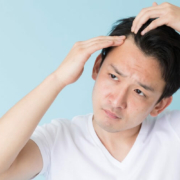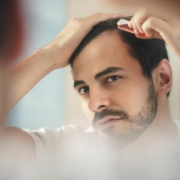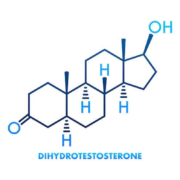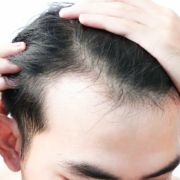Worried About Going Bald? Why Men Are More At Risk Than Women.
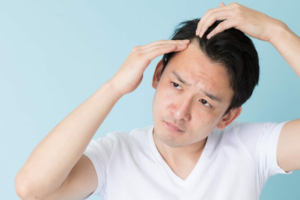
Unless you were lucky enough to be born with perfect genes, the odds are that you’ll experience hair loss at some point in your life if you’re a guy. By age 35, about two-thirds of all men begin to notice that their hair isn’t quite as thick as it once was. Or even more alarming, they start to see a bit of recession on their foreheads. By the age of 50, that number shoots up to 85 percent. (01) Yes, women lose their hair too. But why does it seem like men have noticeable hair loss while women still have their standing weekly appointments to get their hair blown out?
Androgenetic alopecia affects both men and women. However, it affects each gender differently. If you’re wondering why male pattern hair loss seems so much more prevalent, we’re here to fill you in. We have the facts and tips on what you can do if thinning or recession are stressing you out.
Why Do Men Go Bald?
There are several reasons why men lose their hair. The most common is due to androgenetic alopecia, male pattern baldness. The hair loss condition is genetic. You can inherit it from either your mother’s or father’s side of the family. Hair loss begins when testosterone converts to an androgen called dihydrotestosterone (DHT). DHT attacks the hair follicles and shrinks them during a process called miniaturization. When the hair follicles miniaturize, a couple of things happen. First, the hair that is already there falls out. Secondly, the smaller hair follicles make it more difficult for new hair to emerge. Newer hair tends to be finer. Eventually, the follicles close off, leading to thinning and baldness. While most people think of balding happening to older men, the truth is that male pattern baldness can affect any male after puberty. It’s not unusual for men in their 20s and 30s to lose their hair.
Does Too Much Testosterone Cause Male Pattern Baldness?
There’s a theory that bald men have more testosterone than men with a full head of hair. Which would explain why more men than women go bald. That’s just a myth, though. The amount of testosterone isn’t what causes male pattern baldness. The amount of testosterone that converts to DHT is what matters. If a man has low testosterone levels, but a high percentage of the testosterone he does have converts to DHT, male pattern baldness can result.
Can Women Go Bald Too?
Women experience androgenetic alopecia too. It’s called female pattern baldness. However, women’s and men’s hair loss patterns are different. Men tend to lose hair in the front of their heads and on top. Male pattern baldness often starts as an M shape. If the condition progresses, it can result in a donut shape. The pattern of women’s hair loss is different, however. Women tend to lose their hair along the part line. Although the hair loss can and does spread, women with female pattern baldness usually don’t go completely bald the way men do. That’s one of the reasons why it seems like men are more affected by genetic hair loss.
If a Man Loses His Hair Due to Male Pattern Baldness, Can it Grow Back?
Men with androgenetic alopecia can regrow their hair if the hair follicles have not fully miniaturized and are still intact. It’s also possible to make thinner hair fuller and healthier looking. Fortunately, there are two FDA-approved medications designed to help.
Minoxidil Is Easily Accessible
The first is Minoxidil. You can buy Minoxidil over-the-counter at drug stores and big box retailers that sell pharmaceutical products. Minoxidil is sold in two and five percent liquid and foam formulas. Higher percentages, up to ten percent, are available by prescription. Not surprisingly, research indicates that five percent (02) is more effective in achieving regrowth. Researchers do not know the exact mechanism that makes Minoxidil work. But, they do know that Minoxidil brings oxygen to the scalp, enlarging hair follicles, preventing miniaturization and hair loss.
Finasteride Is a First-line Prescription Treatment for Male Pattern Hair Loss
Finasteride is a prescription DHT blocker that has been FDA-approved to treat male pattern baldness. The medication, marketed initially to treat enlarged prostates, is effective in promoting hair growth and stopping hair loss in men. (03) Finasteride prevents testosterone from converting into DHT, which can attack and shrink the hair follicles. Some men, however, are reluctant to try or use Finasteride because it has a reputation for causing sexual side effects. Using topical Finasteride is a good, often preferred, alternative that allows men to benefit from the medication without experiencing systemic effects.
Treatment for Male Pattern Baldness Often Requires a Combination of Prescription Medications
If you’re starting to see thinning or bald spots and are worried about losing your hair, don’t wait to seek treatment. As mentioned, you want to act while your hair follicles remain active. A combination of medications are typically used at the same time. Minoxidil and Finasteride are often prescribed together. Minoxidil, a vasodilator, enlarges the follicles, while Finasteride stimulates growth. (04) Depending on your particular case, your dermatologist may also recommend Retinol to help absorption, Cortisone to eliminate irritation or other medications. Liquid formulas that combine multiple medications into one are available if you’re concerned about taking multiple medications and side effects.
Customized Hair Loss Treatments Can Be Modified
Keep in mind that treatment for male pattern baldness isn’t one-size-fits-all. It may take some trial to determine which combination of medications works best for your body’s chemistry. Finasteride is typically the first-line treatment since it’s highly effective. However, some men find that Dutasteride, a more broad-spectrum DHT blocker, works better for them. The key is to remember that once you start treating your hair loss and find a solution that works, you’ll need to keep using it. If you stop treatment, any growth will be lost.
No, you can’t change your genetic makeup, but you can treat your hair loss. If you have questions about what medications are right for you, contact us. Our board-certified dermatologist will review your case and recommend the best way to start regrowing your hair.
Resources:
(01) https://www.americanhairloss.org/men_hair_loss/index.html
(02) https://pubmed.ncbi.nlm.nih.gov/12196747/
(03) https://pubmed.ncbi.nlm.nih.gov/9951956/
(04) https://www.ncbi.nlm.nih.gov/pmc/articles/PMC4314881/

